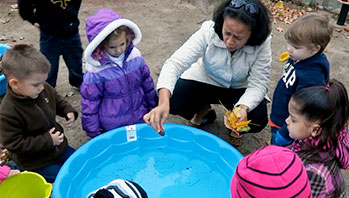- balls (various sizes and weights)
- camera or cell phone with camera
- clipboard and pencil
- objects to serve as obstacles (cardboard tubes, toy cars, blocks, pencils, etc.)
- ramp-building materials
- move
- obstacle
- roll
- surface
- texture
MA Standards:
English Language Arts/Language/L.PK.MA.6: Use words and phrases acquired through conversations, listening to books read aloud, activities, and play.
MA Draft Standards:
Physical Sciences/Motion and Stability; Forces and Interaction/PS2.A: Plan and carry out investigations of the behaviors of moving things.
Physical Sciences/Motion and Stability; Forces and Interaction /PS2.B: Using evidence, discuss ideas about what is making something move the way it does and how some movements can be controlled. [Cause and Effect, Stability and Change]
Head Start Outcomes:
Approaches to Learning/Cooperation: Plans, initiates, and completes learning activities with peers.
Logic and Reasoning/Reasoning and Problem Solving: Seeks multiple solutions to a question, task, or problem.
Logic and Reasoning/ Reasoning and Problem Solving: Uses past knowledge to build new knowledge.
Approaches to Learning/Persistence and Attentiveness: Sets goals and develops and follows through on plans.
PreK Learning Guidelines:
English Language Arts/Language 2: Participate actively in discussions, listen to the ideas of others, and ask and answer relevant questions.
Explore Together (outdoors): Free Exploration

© Commonwealth of Massachusetts, Department of Early Education and Care. All rights reserved.
STEM Key Concepts: A ramp, or inclined plane, is a surface with one end higher than the other; An object placed on an inclined plane will roll, slide, or stay put; The shape of an object affects whether it will roll or slide or stay put; The motion and speed of a rolling or sliding object is affected by the texture of the object and the texture of the surface on which it is rolling or sliding; When a rolling ball hits an obstacle, it will stop or slow down and its direction may change
ELA Focus Skills: Speaking and Listening, Vocabulary
Take children outdoors to continue building obstacle courses. Guide them to notice the surface textures they encounter outdoors and how the balls, obstacles, and other objects they use move on the different surfaces. Help children place obstacles and vary the way they place them.
- What are some other ways you can use the paper towel tube as an obstacle?
Ask children to describe how the balls and obstacles move when they collide. Help children to notice what happens when they use different obstacles. Ask questions such as,
- Is it easier to roll the ball on the grass or the concrete? Why do you think that is?
- How did that help you to knock the paper towel tube over?
Reflect and Share
Invite children to share what they observed in their explorations. Share photos you took and have the obstacles available so children can demonstrate as they speak. Encourage the use of the word obstacle in their descriptions. Guide them to reflect on what they observed. For example, ask,
- What was different about how the ball reacted when it hit the paper towel tube and when it hit the pile of books?
- How did you change your obstacle course to make the ball knock over the blocks?
Social Emotional Tip: Help children learn to approach a task with flexibility and inventiveness and to demonstrate initiative by making independent choices.
Adaptation: You might prefer to have each younger child do the activity individually, with one-to-one supervision.
